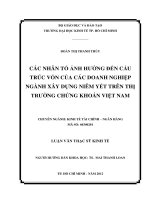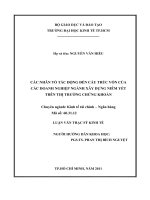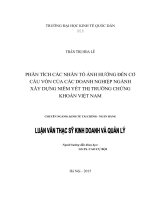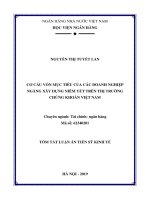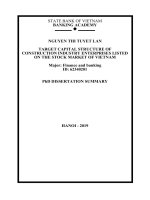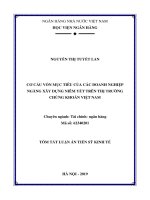Cơ cấu vốn mục tiêu của các doanh nghiệp ngành xây dựng niêm yết trên thị trường chứng khoán việt nam tt tt
Bạn đang xem bản rút gọn của tài liệu. Xem và tải ngay bản đầy đủ của tài liệu tại đây (178.83 KB, 14 trang )
STATE BANK OF VIETNAM
BANKING ACADEMY
NGUYEN THI TUYET LAN
TARGET CAPITAL STRUCTURE OF
CONSTRUCTION INDUSTRY ENTERPRISES LISTED
ON THE STOCK MARKET OF VIETNAM
Major: Finance and banking
ID: 62340201
PhD DISSERTATION SUMMARY
HANOI - 2019
THE DISSERTATION IS COMPLETED
AT BANKING ACADEMY
Scientific instructors:
1. Assoc. Prof. Le Van Luyen
2. Assoc. Prof. Nguyen Thi Hoai Le
Reviewers:
1.
2.
3.
The dissertation will be defensed before the Dissertation
Assessment Council at Banking Academy
At:
Date:
This dissertation can be found at:
- National Library
- Banking Academy’s library
INTRODUCTION
1. Rationale of the topic
In the context of international economic integration, economic sectors, especially
capital intensive industries such as Construction industry, have access to more capital
sources to expand scale and growth. During the period from 2005 to 2009, the annual
average growth rate of the construction industry reached 9.6% and it reached 4.6% during
the 2010-2015 period. It is estimated that from now to 2020, Vietnam needs to attract about
VND 202 trillion each year to develop transport infrastructure and about VND 125 trillion
each year for electricity infrastructure projects. This will be a tremendous resource for the
construction industry to develop in the future.
However, in addition to the development opportunities, enterprises in the
construction industry in Vietnam still face many difficulties since the economy started to
integrate and develop. These issues make construction enterprises increasingly interested in
the problem of corporate financial management with the focus on capital structure issues of
enterprises. Appropriate target capital structure will help construction industry enterprises
maximize the value of enterprises, limit financial risks and be a solid foundation to help
businesses cope with fluctuations from outside. The study of capital structure, especially
the factors affecting capital structure of the construction industry is very necessary and
highly practical in practice.
Capital structure is an important issue in corporate financial management.
Therefore, researchs on capital structure attract much attention from scientists all over the
world as well as those in Vietnam. Since the publication of Modiglani & Miller (1958),
many authors have done researches on capital structures in developed countries such as
Rajan and Zingales (1995) (Countries G-7), Burgman (1996) (USA), Bevan and Danbolt
(2002) (England), Akhtar and Oliver (2009) (Japan) ... and developing countries such as
Booth et al. (2001) ( Brazil, Mexico, India, Korea, Jordan, Malaysia, Pakistan, Thailand,
Turkey and Zimbabwe), Pandey (2001) (Malaysia), Chen (2003) (China) ...
In Vietnam, in recent years, many researches on capital structure have been done.
For example, researches by Le Dat Chi (2013), Vo Thi Quy (2014), Le Thi Thanh Tu
(2012), Do Van Thang and Trinh Quang Thieu (2010), Le Hoang Vinh (2009). In the
context that the world economy is in recession and the domestic economic situation still
has many difficulties, in order to survive and develop, businesses need to maximize their
internal strengths. Building a proper capital structure is also a way for businesses to
promote that power. Capital structures that depend mostly on debt or skews to the use of
equity may be appropriate at this stage but not at another stage.
Thus, in the world and in Vietnam there have been many researches on capital
structure. Dealing with capital structure, first, managers must consider what are the factors
affecting capital structure and how they affect capital structure. Then, managers should
also know the effect of capital structure on the performance of their companies. There have
been many empirical studies on the factors affecting capital structure, each study dispersed
into different areas. However, the factors affecting capital structure and the impact of
capital structure on the performance of the construction industry are almost limited.
Therefore, the author chooses the topic: "Target capital structure of construction industry
enterprises listed on the stock market of Vietnam" as the dissertation topic.
2 Research objectives
This dissertation analyzes the target capital structure through analyzing the capital
structures of listed construction companies on Vietnam's stock market. The results of
empirical analysis will be one of the important bases for investors and managers to decide
more appropriate capital structure to improve the performances of enterprises. Specifically,
the study will answer the following questions:
i)
What are the factors that affect the capital structure of listed construction
companies on the stock market of Vietnam?
ii)
How does capital structure affect business performance (profit margin) of
construction companies listed on the stock market of Vietnam?
iii)
Determine the target capital structures for listed construction companies in
Vietnam's stock market.
3 Research subject and scope
- Research matters: Capital structure and target capital structure of construction
companies listed on Vietnam stock market. Specifically, the dissertation studies the
effects of factors on the capital structures of construction companies listed on
Vietnam's stock market. From the research model, the dissertation builds the target
capital structure for construction companies listed on the Vietnam stock market
- Research subject: Construction industry companies listed on the stock market of
Vietnam
- Research scope: The dissertation carried out survey and practical analysis for 109
construction industry companies listed on Vietnam stock market. In which, there
are 75 companies listed on Hanoi Stock Exchange (HNX) and 34 companies listed
on Hochiminh Stock Exchange (See Appendix 1). With secondary data collected
during the period from 2005 to 2017 and primary data is taken in 2018.
- Research perspective: This is an independent research which is done with the
perspective of managers of construction industry enterprises.
4. New contributions of the dissertation
The dissertation makes contribution on both theoreotical and practical aspects.
Theoretical aspects:
First, this research reviews, analyzes and evaluates theories and research findings
on factors affecting enterprises’ capital structures and the role of capital structure to
enterprises’ performances. As a result, this research will make a certain contribution to the
systemization and development of theories about capital structure and theoretical views
about enterprises’ target capital structures.
Secondly, this research contributes to the development of measurement methods
for enterprises’ target capital structures.
Thirdly, this dissertation is a combination of academic research and application
research. In this research, a model is developed to test the hypotheses and interviews and
surveys are conducted to allege the research result. Thus, this dissertation has developed
one more step in term of methodology and research tools for this topic.
This dissertation is first developed to provide an academic analysis on how to build
target capital structures for enterprises and assess its impact on business performances. I
expect that the method suggested from this research will be applied in the financial
management process of enterprises in the construction industry in particular and those of
businesses in Vietnam in general.
Practical aspects:
First, the dissertation’s result provides researchers and financial managers with
comprehensive view of how to approach and measure enterprises’ target capital structures.
Secondly, the research evaluates the impact of target capital structure on
enterprises’ performance. It has showed that using debts will result in positive
performances of businesses at first. However, once the threshold is exceeded, the use of
debt will adversely affect the performance of enterprises.
Thirdly, this dissertation uses both quantitative and qualitative research methods.
Through the quantitative model developed, the research has constructed the target capital
structure and evaluated its impact on the performances of enterprises in the construction
industry which are listed on Vietnam stock market. At the same time, the dissertation
exploits a qualitative research tool which is in-depth interviews with financial managers to
evaluate the quantitative research result. Thus, this dissertation can be a reference for
research methodology, research design, research model and data processing for
researchers, lecturers and students of the same interest.
5. Dissertation’s structure
Apart from the table of content, list of abbreviations, List of tables, list of charts, list of
reference and appendices, the dissertation is structured into 5 following chapters:
Chapter 1: Overview of researches and theoreotical basis about capital
structure and target capital structure of enterprises
Chapter 2: Research methodology
Chapter 3: Current situation of capital structures and performances of construction
industry enterprises listed on the stock market of Vietnam for the period from 2005 to 2017
Chapter 4: Empirical research result about capital structure and target capital
structure of construction industry enterprises listed on the stock market of Vietnam
Chapter 5: Suggested solutions for building the target capital structure in order to
enhance the performances of construction industry enterprises listed on the stock market of
Vietnam
CHAPTER 1
OVERVIEW OF RESEARCHES AND THEOREOTICAL BASIS ABOUT CAPITAL
STRUCTURE AND TARGET CAPITAL STRUCTURE OF ENTERPRISES
1.1 Overview of researches about capital structure and target capital structure
1.1.1 Foreign researches
1.1.2
1.1.3
Researches in Vietnam
Research hole
Theoretical and empirical studies in the world have shown that there are many
different factors affecting the capital structure of businesses. Different observed samples and
data in different time periods give very different conclusions. Therefore, when discussing
factors that have a real impact on the capital structure of enterprises, we must consider and
analyze based on the specific characteristics of the research object. At the same time, to
determine the target capital structure of enterprises, it is necessary to base on the estimated
results of the model of factors affecting the capital structure of enterprises.
In Vietnam, there have been many researches on capital structure. However, there has
not been any specific study on capital structure and target capital structure for construction
industry enterprises listed on Vietnam stock market. On the other hand, previous researches
on capital structure of enterprises are done using data for a short period of 2 to 3 years which
are not long enough to see the long-term trend. Therefore, this dissertation, on the basis of
inheriting the advantages of the previous studies such as the theoretical basis of the factors
affecting the capital structure of enterprises and the impact of capital structure on business
performance of enterprises, etc., will fulfill the following research holes: i) Summarize and
give theoretical views on the target capital structure of enterprises; ii) Analysis of factors
affecting capital structure, thereby building the target capital structure for enterprises; iii) The
dissertation analyzes the impact of target capital structure on business performance of listed
construction companies on Vietnam's stock market; iv) The thesis conducted in-depth
interviews with financial managers of enterprises to reaffirm the quantitative research result.
1.2 Theoreotical basis about capital structure and target capital structure
1.2.1 Overview of capital structure
1.2.2 Theories about capital structure
Durand’s traditional theory about capital structure
Modigliani and Miller’s capital structure theory
Trade-off theory about capital structure
Pecking order theory
The market timing theory
1.1.2 Target capital structure of enterprises
The target capital structure is the capital structure associated with the
operational objectives of the business at each stage, when the business objectives of the
enterprise change, the target capital structure also changes. Thus, the target capital
structure is not a static concept. Measuring the target capital structure is to measure the
capital structure associated with the business objectives. More specifically, the target
capital structure is planned by the company to mobilize more capital. Target capital
structure may change when the conditions change. Target capital structure is a structure
that a business often uses when deciding to expand its business capital. In fact, the
capital structure of enterprises can fluctuate around the target structure for two reasons.
First, business leaders can make decisions based on specific situations. For example,
the temporary increase in share prices will create a golden opportunity for businesses to
issue shares and increase the equity ratio. Secondly, the market prices of corporate
stocks and bonds are always volatile, leading to a real capital structure deviating from
the target capital structure.
In the capital structure trade-off theory (TOT), the decision maker of the capital
structure of the enterprise will review and evaluate all costs and benefits in situations of
other capital structure states. This theory assumes that enterprises when making capital
structure decisions will achieve a balance between marginal cost and marginal benefits.
Unlike the static trade-off theory of capital structure that provides the optimal
capital structure solution in a period, the dynamic trade-off theory of capital structure
emphasizes the importance of time, the role of expectations and cost adjustment (Fischer,
Heinkel and Zechner, 1989). This has flexibility in deciding the capital structure of
businesses. According to the dynamic trade-off theory of capital structure, enterprises will
try to adjust the capital structure towards the target capital structure. In this dynamic
model, factors that affect the target capital structure have been addressed and considered
more comprehensively compared to the static model such as profitability, dividends and
corporate income tax career.
On the other hand, Myers (1984) and Myers and Majluf (1984) developed a betting
model on the basis of asymmetric information theory. Under this approach, managers do
not follow any target capital structure, but they have a priority order on different financial
sources: equity (ie unallocated income), external debt financing and equity financing. At
the same time, Myers (1984) pointed out that the target capital structure cannot be directly
observed but can only be estimated from experimentation, the actual tax law is much more
complex than the assumptions of theories, and the cost of bankruptcy causes real losses
rather than be transferred from one person to another as in theory, and transaction costs
must also be taken into account.
The target capital structure in this dissertation is based on the theory of dynamic
exchange and based on the view of Myers (1984). Specifically, the target capital structure
model is as follows:
CCVit = + Xit + it
(*)
where CCVit is the capital structure of enterprises i at time t, which is measured by total
debt on total assets (Tran Thi Bich Ngoc, 2017; Vo Minh Long, 2017; Dang Thi Quynh Anh and
Quach Thi Hai Yen, 2014; Zeitun and Tian , 2007; Ebaid, 2009 and Pratheepkanth, 2011); X it is
the vector of factors affecting capital structure; it is noise. The estimated results of the model (*)
are the enterprise's target capital structure at time t.
1.3 Factors affecting capital structure
1.3.1 Microeconomic factors
1.2.1 Macroeconomic factors
1.4 Impact of target capital structure on enterprises’ performance
1.4.1 Enterprises’ business performance
1.4.2 The role of capital structure to enterprises’ business performance
CHAPTER 2: RESEARCH METHODOLOGY
This dissertation exploits both quantitative and qualitative research methods.
Quantitative research is used to evaluate factors affecting enterprises' capital structure, and
via this model, the dissertation builds the target capital structure for construction industry
enterprises listed on Vietnam stock market. After that, the dissertation assesses the impact
of target capital structure on enterprises' performance. Finally, the dissertation uses a
qualitative research tool which is in-depth interview with financial management managers
to evaluate quantitative research results from the perspective of experts and practical
applications.
2.1 Analytical framework and research model
Based on the trade-off theory of capital structure, pecking order theory, theory of
corporate finance and based on the results of empirical researches summarized in Chapter
1, the dissertation uses the analytical framework as shown in Figure 2.1 below.
Figure 2.1 The dissertation’s analytical framework
Enterprise scale
Non-debt tax benefit
Enterprise’s
capital structure
Profitability
Tangible fixed assets
Real tax rate
Growth opportunities
Enterprise’s target
capital structure
Enterprise’s
performance
Risks
Liquidity
In-depth interviews with financial managers
Dividend payment ratio
Enterprise’s own
charateristics
Source: Builded by the author based on theoretical basis
According to this analytical framework, the dissertation will perform two empirical
analyses. First, this research analyzes the factors affecting the capital structure of
enterprises. Based on the model estimation results, the dissertation will build the target
capital structure for enterprises. Secondly, the research analyzes the effect of the target
capital structure on business performance. Finally, to reevaluate the results of quantitative
research, the author conducts in-depth interviews with financial managers of construction
enterprises listed on Vietnam's stock market.
Based on the research model of Drobetz and Wanzenried (2006) and research by
Tran Hung Son (2011), the dissertation builds the model of factors affecting capital
structure as follows:
CCV = β0 + β1*SIZE + β2*NDTS + β3*PRFT + β4*TANG + β5*TAX +
β6*GROWTH + β5*RISK + β5*LIQ + β5*DIV + β5*UNIQ + ui
(2.1)
Based on the research model of Doan Vinh Thang (2016) and Doan Ngoc Phuc
(2014), the dissertation builds the model estimating the influence of the target capital
structure on the performances of enterprises as follows:
HQHĐ = β0 + β1*CCVMT + β2*SIZE + β3*PRFT + β4*TANG + β5*GROWTH +
β6*LIQ + ui
(2.2)
2.2 Data sources
The research data used for quantitative research are taken from StockPlus with
research subjects that are companies in construction industry in Vietnam listed on the two
exchanges namely HNX and HOSE in the period of 2005-2017.
2.3 Estimation method
2.4 Qualitative method
Besides the quantitative research method discussed above, the dissertation uses
additional qualitative research method to re-evaluate the result found by the quantitative
research. Specifically, the dissertation surveyed a number of listed construction enterprises
on the Vietnamese stock market. The author conducts in-depth interviews with financial
managers of enterprises on their assessment of the model used by this dissertation to build
enterprises’ target capital structure, and has them compare it with the actual ways exploited
by enterprises to build their target caiptal structure. Also, enterprises’ financial managers
are asked to give their assessment of the impact of target capital structure on the
performance of their enterprises. During the interview process, the author integrates new
ideas and findings from the previous interview into the next interviews, and finally all the
new ideas and findings were used by the author for data analysis.
The interview sample selected includes financial managers (Chief Financial Officer
/ Chief Accountant) of construction industry enterprises listed on Vietnam stock market,
which have the highest and low debt use indice. According to statistics from quantitative
data, there are about 6/109 businesses with debt use rate of less than 30% per year and
39/109 businesses with debt use rate of over 80%. The interview sample is focused on
these businesses. Specifically, the dissertation asked all 6 enterprises having the debt
utilization rate of less than 30% and only 9 enterprises with debt use of over 80%. Due to
the requests of the interviewed subjects, the dissertation does not disclose information
about the interviewees. The time for conducting interviews is from July to August 2018.
CHAPTER 3
CURRENT SITUATION OF CAPITAL STRUCTURES AND PERFORMANCES OF
CONSTRUCTION INDUSTRY ENTERPRISES LISTED ON THE STOCK
MARKET OF VIETNAM FOR THE PERIOD FROM 2005 TO 2017
3.1 Overview of the construction industry in Vietnam
3.1.1 Historical development of the construction industry
3.1.2 Characteristics of Vietnam construction industry
3.1.3 Construction costs
3.1.4 Construction market
3.2 Current situation of capital structures and performances of construction industry
enterprises listed on the stock market of Vietnam for the period from 2005 to 2017
CHAPTER 4
EMPIRICAL RESEARCH RESULT ABOUT CAPITAL STRUCTURE AND
TARGET CAPITAL STRUCTURE OF CONSTRUCTION INDUSTRY
ENTERPRISES LISTED ON THE STOCK MARKET OF VIETNAM
4.1 Statistical description and correlation among variables
4.2 Estimation result and discussion
4.2.1 Estimation result and discussion about factors affecting the capital structures of
construction industry enterprises listed on the stock market of Vietnam
The model used for analysis is a robusted random effect model because Hausman
test gives a large p-value. The estimated effects of the factors affecting capital structure of
listed enterprises in Construction industry are shown in Table 4.3.
Estimation result shows that tangible fixed assets (TANG), Actual Tax Rate (TAX),
Growth Opportunities (GROWTH), Risk (RISK), do not affect the target capital structure
of listed enterprises in construction industry. This result does not support research
hypotheses H4, H5, H6, H7. In contrast, the regression coefficients of the Scale factors
(SIZE), Non-debt tax benefits (NDTS), corporate profitability (PRFT) Liquidity (LIQ),
Dividend payment ratio (DIV) and the characteristics of corporate assets (UNIQ) are
significant at 10% level. This implies that these factors affect the capital structure of
enterprises listed in Construction industry in Vietnam. Some have positive effects and
some have negative effects.
In addition, the estimation of the capital structure derived from the model is the
target capital structure of enterprises (Doan Vinh Thang, 2016). Based on the model’s
estimation result, the author builds the average target capital structure of listed construction
enterprises on Vietnam stock market over the years as shown in Table 4.4.
Table 4.4 Average target capital structure of construction industry enterprises listed
on the stock market of Vietnam for the period from 2005 to 2017
Lower bound of target
Upper bound of target
Year
capital structure
capital structure
2005
0,641
0,661
2006
0,647
0,662
2007
0,614
0,664
2008
0,617
0,663
2009
0,638
0,659
2010
0,645
0,655
2011
0,648
0,657
2012
0,650
0,659
2013
0,640
0,658
2014
0,642
0,658
2015
0,647
0,658
2016
0,626
0,642
2017
0,614
0,638
Source: Calculated by the author
Accordingly, the average target capital structure of construction industry enterprises
listed on Vietnam stock market over the years is relatively stable (about 60%).
4.2.2 Estimation result and discussion about the impact of target capital structure on
performance of construction industry enterprises listed on the stock market of Vietnam
The model used for analysis is a robusted fixed effect model because Hausman test
give small p-value results. The estimation of the effects of target capital structure on the
performance of listed construction enterprises is shown in Table 4.5 and Table 4.6.
Estimation result with ROA (Table 4.5) indicates that regression coefficient
associated with target capital structure is negative and significant at 10% level of
significance. This implies that target capital structure has adserve effect on the rate of
return on assets of listed construction enterprises in Vietnam. This result does not support
the research hypothesis H11. However, the result supports the view of Maslis (1983).
Accordingly, if the debt ratio is in the range of 0.23 to 0.45, the debt ratio positively affects
the performance of businesses. If the debt ratio is higher, it has a negative effect on the
performance of the businesses. Similarly, Dilip Ratha's (2003) study shows that financial
leverage negatively affects the performance of enterprises in developing countries. On the
other hand, for a long period from 2006 to 2012, the lending interest rates increased. As a
result, using a lot of debts is not conducive to the performances of enterprises.
The estimation result with ROE (return on equity) is shown in Table 4.6. Similar to
the estimation result with ROA, the capital structure also has the opposite effect on ROE of
construction enterprises in Vietnam. In addition, variable controlling firm size also has
positive impact on ROE while liquidity has adverse effect on ROE.
In order to investigate whether the effect of the target capital structure on the
performance of the business is subject to the diminishing marginal return law, the author
added to the model the square of target capital structure (CCVMT2). Estimation result is
shown in Table 4.7 and Table 4.8.
Similarly, the model used for analysis is a robusted FE model to control assumption
violations of the model (autocorrelation and variance variance). The result for ROA shows
that the target capital structure affects ROA and the effect of the target capital structure on
ROA follows the diminishing marginal return rule (inverted U). Accordingly, when
enterprises increase the use of debt, ROA increases. However when the debt ratio exceeds
the threshold of 72.7% (- (0,761) / (2 * (- 0,523)), ROA decreases as debt ratio increases.
The estimation result with ROE is completely similar to that with ROA.
Accordingly, the capital structure has impact on ROE and that effect follows the
diminishing marginal rule. When businesses increase the use of debt, ROE will increase
but when the debt ratio exceeds the threshold of 74% (- (1,074) / (2 * (- 0,723)), ROE will
decrease.
4.3 Qualitative research result
Enterprises being asked about the level of agreement on the views of capital
structure and the target capital structure used by the dissertation all show 100% of
agreement with those views.
Enterprises with low debt ratios are mostly those with low business perfromances.
These enterprises are in difficult situation with outdated fixed assets, small market share
and weak competitiveness. These enterprises use low debt ratio to limit the negative effects
of debt balance and reduce pressure on debt payments. However, when the author surveyed
the low debt group, the author realizes that there are enterprises having large assets but
using no debt. These enterprises explained that “in order to solve the problem of capital
shortage, enterprises often choose the solution of equity and are not much interested in
using debt financing". Thus, it can be seen that enterprises seem to have forgotten the
benefits of using financial leverage. Enterprises of the low debt group also added
additional reasons involving their specific business activities such as long construction
projects, scattered investment capital and slow capital recovery.
Enterprises with high debt ratios are mostly those with high business performances,
strong competitiveness and large market shares. Among enterprises that use a large
proportion of debt, most of them have short-term debts and their purposes of borrowing are
to finance compensation, clearance and payment of land use fees and to pay to third parties
for the completion of legal requirements of major projects. The group of businesses that
use high debt includes entirely large enterprises.
Enterprises all express high level of agreement with the method used by the author
to build target capital structure and also affirm that the result of target capital structure
found by the dissertation is relatively accurate compared to the target capital structure set
by their enterprises annually. However, when being asked about the role of target capital
structure on business performance, these enterprises show different opinions. The group of
enterprises using high debt ratios shows high level of agreement (66.67%) with the
statement that target capital structure has a positive influence on their business
performances; whereas the group with low debt ratios has very different opinion. Some
argue that "when the debt ratio is high, the risk increases because if the cost of capital
increases and it exceeds the profitability of the enterprise, the performance of the enterprise
will fall." Some believe that the impact of target capital structure on enterprises’
performances depends much on the general economic situation of the economy. During the
period of recession of enterprises or the economy, revenue will decrease. At that time, the
higher the debt ratio is, the higher the interest payable is, resulting in lower profit and
worse business performance. On the contrary, during the expanding period of businesses or
the economy, revenue will increase. If the debt ratio is high, it means high financial
leverage which leads to the increase in profits and better business performance.
CHAPTER 5
SUGGESTED SOLUTIONS FOR BUILDING THE TARGET CAPITAL
STRUCTURE IN ORDER TO ENHANCE THE PERFORMANCES OF
CONSTRUCTION INDUSTRY ENTERPRISES LISTED ON THE STOCK
MARKET OF VIETNAM
5.1 Prospectives of the construction industry
5.2 Solutions to build the target capital structure and enhance business performances
of construction industry enterprises listed on the stock market of Vietnam
5.2.1 Properly adjust enterprise scale
5.2.2 Enhance business operating efficiency
5.2.3 Increase equity and exploit more capital mobilization channels
5.2.4 Invest in the renovation of fixed assets
5.2.5 Innovate operating method
5.2.6 Expand the list of collaterals
5.2.7 Complete the enterprise evaluation system
5.2.8 Enhance information transparency
5.2.9 Complete forms of financial support for enterprises
5.2.10 Develop and expand loan markets
5.3 Policies and laws related to Construction industry
5.3.1 Policy to stimulate the demand of Real estate market
5.3.2 Bidding Law 2013 And Decree 63 on bidding
5.3.3 New legal framework for PPP form
5.3.5 Development plans
CONCLUSION
1. General conclusion
Based on the theoretical basis of corporate capital structure, this study has analyzed
the factors affecting the capital structure of listed construction industry in Vietnam from
2005 to 2015. Empirical research result shows that factors that affect capital structure
include Scale (SIZE), Non-debt tax benefits (NDTS), Business profitability (PRFT) and
Liquidity (LIQ). In contrast, factors that do not affect the target capital structure include
tangible fixed assets (TANG), Actual Tax Rates (TAX), Growth Opportunities
(GROWTH), Risks (RISK), Ratio dividend payment (DIV) and specific characteristics of
corporate assets (UNIQ).
Besides, the dissertation studies the impact of capital structure on the performance
of listed construction enterprises in Vietnam from 2005 to 2015. The result of empirical
research shows that structure capital positively affects the performance of the business.
Researchers and managers do not completely deny the important role of debt an
enterprise's capital structure. To a certain extent, debt enhances the company's business
performance due to the effect of the tax shield (Myers, 1997; Tharmila and Arulvel, 2013)
or the reduction in equity cost (Jensen and Meckling, 1976). In addition, debt also helps
enterprises expand quickly to take advantage of economies of scale while still maintain the
controlling of businesses due to undiluted shares (Kyereboah - Coleman, 2007).
On the other hand, the effect of capital structure on the performance of listed
companies in construction industry complies with the law of diminishing marginal return.
Specifically, when enterprises increase the use of debt, the operational efficiency of
enterprises increases but when the debt ratio exceeds the threshold of 72.4%, the ROA
decreases. When debt ratio exceeds 74%, ROE will decrease.
Based on this conclusion, the dissertation suggests some solutions to improve the
capital structure and enhance the performances of listet enterprises in Vietnam construction
industry.
2. Limitations of the dissertation and future research direction
Apart from the new contributions, the dissertation has the following limitations:
(i)
The thesis only concentrates on analyzing the capital structure of
construction enterprises without a comparison with other enterprises in the
industry.
(ii)
The thesis only assesses the impact of internal factors on the capital
structure of enterprises without assessing the influence of external factors.
In the future, the author will continue to eliminate the above limitations.
.
LIST OF THE AUTHOR’S PUBLISHED RESEARCHES
1. Nguyen Thi Tuyet Lan (2017), "The impact of capital
structure on business performance of construction
companies listed on Vietnam stock market", Banking
Science and Training Review, No. 185 October 2017,
page 59-66.
2. Nguyen Thi Tuyet Lan (2017), “Study the factors
affecting the target capital structure of listed
construction companies on the stock market of
Vietnam”, Banking Science and Training Review, No.
178, March 2017, page 39-47, 56.
3. Le Van Luyen, Nguyen Thi Tuyet Lan (2017), "Factors
affecting the access to loans of construction enterprises
in Vietnam", Promoting Financial Inclusion in Vietnam International Conference, page 33 – 40.
4. Nguyen Thi Tuyet Lan, Mai Thi Nhi (2015), "Empirical
evidence of the optimal capital structure threshold of
listed companies on HOSE", Banking Science and
Training Review, No. 158 July 2015.
5. Nguyen Thi Tuyet Lan (2018), "Vietnamese Enterprise
in the Industrial Revolution 4.0", Review of Finance,
2nd period - June 2018 (683), page 57-59
6. Nguyen Thi Tuyet Lan (2016), "ETF - Opportunities
and Challenges for Investors", Proceedings of Scientific
Conference: Development of Exchange Traded Funds
(ETF) in Vietnam, Falculty-level conference, Bach
Khoa Publishing House, May 2016, p. 154-159.
7. Nguyen Thi Tuyet Lan (2015), "Accelerating the
equitization of state-owned enterprises via good debt
handling", Proceedings of scientific conferences:
Financial solutions to accelerate the equitization
process of state-owned enterprise in the near future,
Bach Khoa Publishing House, May 2015, p. 161-165.
8. Nguyen Thi Tuyet Lan (2013), "Why is the restruction
of State-owned Enterprises not really effective?"
Proceedings of conference: Issues arised in the process
of restructuring state-owned enterprises in Vietnam,
Vietnam News Agency Publishing House, April 2013,
page 484-486.
9. Nguyen Thi Tuyet Lan (2011), "State Economic Group
and Potential Risks", Proceedings of Conference:
Financial Management at State-owned Economic
Groups in Vietnam, June 2011.
10. Nguyen Thanh Phuong, Nguyen Thi Tuyet Lan (2012),
"Operations of Vietnamese enterprises with the
fluctuation of interest rates and exchange rates",
Proceedings of Conference: The impact of monetary
policies on the operations of the Vietnamese enterprises
in the current condition, Hong Duc Publishing House,
pp 9-21.
11. Nguyen Thi Tuyet Lan (2013), "Solutions for capital of
small and medium-sized enterprises in Vietnam",
Economy Forecast Review.
12. Nguyen Thi Tuyet Lan (2013), "Causes of ineffective
operations and the necessity to restructure State-owned
Enterprises", Proceedings of conference: Issues arised
in the process of restructuring state-owned enterprises
in Vietnam, Vietnam News Agency Publishing House.
